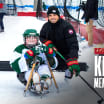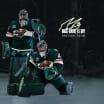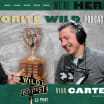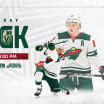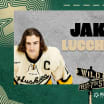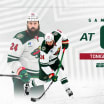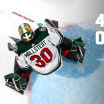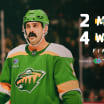This story appears in the January issue of Wild Magazine.
NHL center. Captain. Sports analyst. Coach. Camp counselor?
Wes Walz's diverse résumé traces a winding path through professional leagues and across oceans, but the former Minnesota Wild forward's journey has paused indefinitely in the Twin Cities. Some avid Wild fans see Walz frequently as a studio analyst on FOX Sports North during games, but others know him better as the director of the
Wes Walz Minnesota Wild Hockey School
.
Balancing fun and finesse at Wes Walz's hockey camp
In its eighth year, the Wes Walz Minnesota Wild Hockey School grows hockey from the ground up
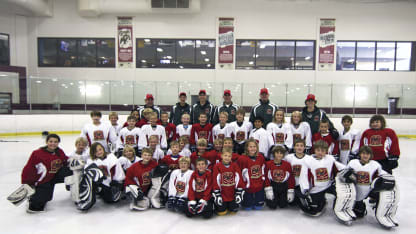
By
Kayleigh Jackson / Wild.com
Now going into its eighth year, the Hockey School's core features are built on cherished experiences from Walz's own childhood.
"I skated and played in a lot of those camps myself and still remember the names of the instructors and the friends I used to go to those camps with," Walz recalled. "We had a ton of fun and it was an amazing experience as a young child, going through some of those camps as a kid.
"I wanted to try to bring the same experience to other kids and see the same goofy looks on their face that I probably used to have when I was 8 to 13 years old.
Walz and the Wild first began the camp to strengthen the connection with youth teams and the growing community of burgeoning hockey players. In the years since, attendance has grown - and so has the pool of talent Walz's campers come from.
"Our numbers at the youth level, the last two, three, four years, have actually skyrocketed," Walz said. "If you start at the grassroots level and kids fall in love with the game then eventually they're going to continue to play."
Though Walz's camp is for players who already have some experience playing hockey - even if it's just a year - other initiatives like the Little Wild program provide a pure introduction to the sport to kids who may never pick up a stick otherwise.
It's a perfect circle. As youth hockey initiatives grow across the State of Hockey, player participation grows. And as more young athletes become interested in an increasingly accessible sport, the need for camps and resources rises. Together, these factors build upon an already formidable youth hockey base across Minnesota to grow the sport from the ground up.
"We've had more kids drafted out of our state than any other state in the National Hockey League, in the United States," Walz said.

So what is the secret to fostering such a strong culture with so many talented players? It's not extreme conditioning, or specific equipment, or something in 10,000 lakes' worth of water.
It's fun.
"I tell our instructors we want to make sure that these kids have a great experience. That is the most important thing," Walz said. With players at the Hockey School ranging in age and experience from mite to bantam, keeping things entertaining is just as important as the hockey lessons.
After all, a spoonful of sugar helps the medicine go down. Or, perhaps in this situation, making friends and scoring goals helps the tougher drills fly by.
Still, there's no substitution for a little elbow grease. Though the fundamentals of youth hockey haven't changed much since Walz's own days at camp, the higher levels of play have drastically changed. Honing certain skills and mindsets at a young age could make all the difference down the road for these players.
Not only has NHL-caliber hockey gotten significantly faster in recent decades, but it has also seen a forced decline in "old-time hockey" plays, such as hooking a player on a breakaway. There is now a premium on skating, and it's trickling down through college and junior hockey as well.
"If you're faster than your opponent, more agile on your feet, that's gonna give you a better opportunity to get away from somebody and give you more room with the puck and time and space to be able to make a play and score goals and set up goals," Walz said. Based on his own experiences, that's become one of the core skills Walz and his instructors emphasize at camp.
One of Walz's favorite drills -- and the only one he specifically asks his instructors to use -- is the C-cut.
The C-cut gets its name from the shape the skater's foot traces onto the ice as he or she takes a stride. Once a player has mastered the correct stride, they can leverage it to generate more power and glide more efficiently across the ice. To an extent, the more a player bends their knee while skating a C-cut, the more powerful their stride will be.
"The more repetitions you get, the better you're gonna get at skating," Walz said. "We try to make sure at our camp the kids are always, always moving."
While that makes for some happy parents at the end of a long work day, it also will help the players in the long run, especially as the upper levels of the game continue to follow the trajectory they're on with an emphasis on speed and power over size and force.
Even if the campers don't realize the importance of skating now, Walz knows they will down the line. It may take them years to master some of the things they learn at hockey camp or with their teams, both physically and mentally.
"The one skill that I didn't have, that I wish I had, that I wish I would have worked on was the skill of being able to deal with failing," Walz said. "Dealing with failure was a big reason why I struggled the first five or six years of my career. And I got better later in my career because I had a better grasp of who I was as a player."
In short, recognizing the necessity of changing and adapting mentally is as important as recognizing the necessity of working out and eating right. Players may never stop learning new things about themselves, on and off the ice, that influence their game. After all, accepting a failure in one realm of their sports career may point them in a new direction.
So, if a player in Walz's camp one day becomes an NHL center, or a captain, or a sports analyst, or a coach, or even a camp counselor … they're in good company.
Related:
- Wild players brave elements before win over Ottawa
- Wild celebrates Hockey Day in style




